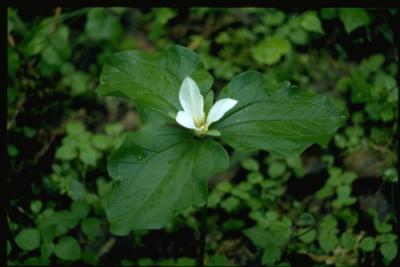Trillium
|
|
| Trillium | ||||||||||||
|---|---|---|---|---|---|---|---|---|---|---|---|---|
| Missing image TrilliumErectum.jpg Trillium erectum Trillium erectum | ||||||||||||
| Scientific classification | ||||||||||||
| ||||||||||||
| Species | ||||||||||||
|
See text |
Trilliums (also Wakerobins) used to be members of the Trilliaceae or Trillium family, a part of the Liliales or Lily order. The AGP II considers now Triliaceae as a synonym of the family Melanthiaceae.
There are many species of these attractive wildflowers. In the east of North America, the most common is Trillium grandiflorum (large-flowered trillium). This plant has a large, often white, three-petaled flower above three broad leaves. Along with its three sepals, it's easy to see where trillium got its name, which it was given by Linnaeus. Trillium grandiflorum is often the first wildflower noticed by casual walkers; other spring wildflowers are much less apparent.
In western North America, a typical species is Trillium ovatum (Western Trillium) also with white flowers.
While trillium flowers are very attractive, they should never be picked, since the three leaves below the flower are the plant's only food source and a picked trillium may die or take many years to recover. For this reason in many areas, e.g. British Columbia, Michigan, New York, Ontario, Oregon, and Washington, it is illegal to pick trilliums.
Trillium is one of the few flowers whose seeds are spread by ants.
Some trilliums have a flower which is bent downward, below the leaves.
A white trillium serves as the emblem of the Canadian province of Ontario.
External links
- Trillium and the Trillium family (http://www.goldsword.com/sfarmer/Trillium)

